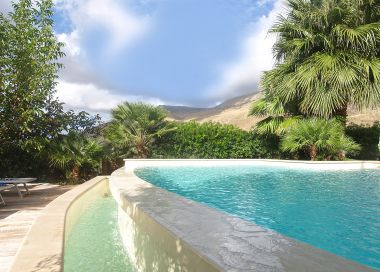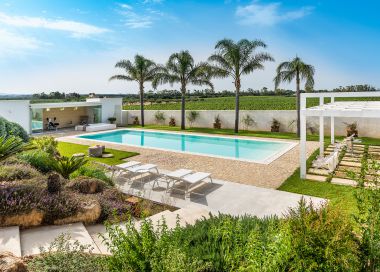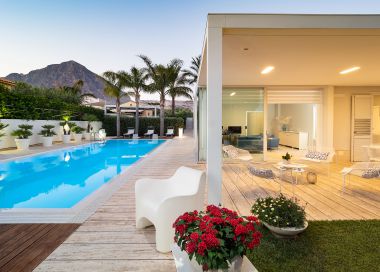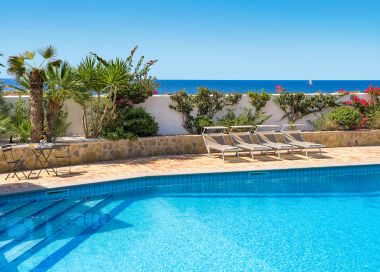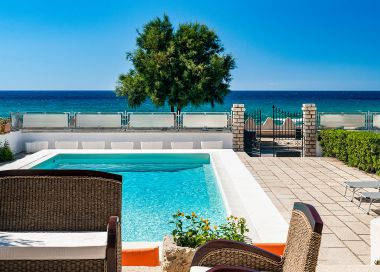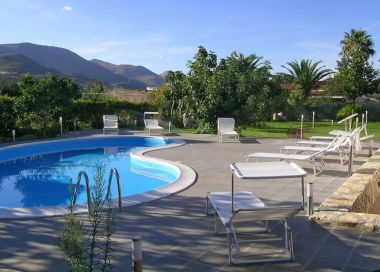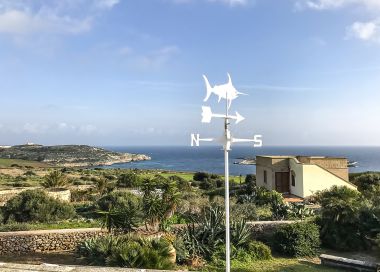Smaller islands around Sicily
Three spectacular archipelagoes, a black pearl and a marine reserve
A rainbow of colours: the black of the sand in Vulcano, the white of the pumice of Lipari, the fiery red of the volcano of Stromboli, the white lime of Panarea, the yellow of the brooms of Filicudi, the purple of the heather of Alicudi, the green of the trees in Salina. The seven pearls of Sicily all have the same volcanic origins but they are, at the same time, both so similar and so different in terms of their structure and morphology. The archipelago stands in the lower Tyrrhenian Sea approximately 40 kilometres from the coast of Sicily. Lipari is the largest of the islands and, although tourism now plays an important role here, the island maintains its traditional charm with a delightful small village and the bright, shining beach at the pumice cave near Canneto. Vulcano, which is clearly of volcanic origin, is an island with many hidden surprises: its active volcano, underwater hot-springs and natural mud pools with a strong scent of sulphur. Venus’ Pool is one of the most beautiful spots; a pool of turquoise water located in the hollow of a rock at the mouth of the Grotta del Cavallo. Salina is the greenest and most cultivated of the islands. It has some delightful spots such as Punta Perciato and an excursion to Monte Fossa delle Felci covered in thick Mediterranean maquis is not be missed. Here you can enjoy a superb view of the whole archipelago. Stromboli, with its black sand and whitewashed houses, has been the most famous of all the islands since ancient times on account of its volcanic activity. Just offshore lies Strombolicchio, a magical block of basalt shaped like a castle. Panarea is the smallest and oldest of the islands. Here you can find the remains of a pre-historic village at Capo Milazzese. During the 1970s it became an island popular with celebrities, attracted by its marvellous bays and beaches. Alicudi, ancient Ericusa on account of the heath growing abundantly on its soil, is a small and wild island, secluded from mass tourism, with only two hundred inhabitants. Filicudi, also not inundated with crowds of tourists, has a small port, some delightful views and an idyllic calm, even during high season; its deep blue sea is the mirror of its soul. You can reach the islands by ferry or hydrofoil from Milazzo and, during the summer season only, by hydrofoil from Palermo. Several years ago the islands were declared a UNESCO world heritage site.
The Egadi Islands, the hidden Mediterranean
The most important and well-known of the Egadi islands is Favignana where they still practice the “Mattanza”, a traditional kind of tuna fishing which takes place during the months of June and July. The island has some wonderful tufa quarries overlooking the sea at Cala Rossa where the bottom of the sea is covered with small, bright pebbles which reflect the light and create an amazing effect. Levanzo, wild and untouched with caves full of ancient cave drawings, unites the beauties of nature with the fascination of the Palaeolithic caves. The mountains of Marettimo reach a height of 700 nearly metres and the island's fishermen are considered to be the most skilful in the whole of the Mediterranean. Three jewels to visit, preferably by boat in order to fully enjoy the beautiful waters in the area. Ferries and hydrofoils run to the islands from Trapani.
Pantelleria, the black pearl of the Mediterranean
Pantelleria was colonised by the Phoenicians in the 7th century B.C. and subsequently occupied by the Greeks who called it Kossyra, “the small one”. The island's present name derives from the Arab "bint- al-rion" which means “daughter of the wind”. It is the greenest of Sicily's islands, wild and desolate and with no sandy beaches but a wonderful indented coastline, strewn with inlets and pine woods. Prickly pears and vines are cultivated inland where the landscape is covered with “dammusi”, typical local houses made of lava stone with a dome-shaped roof. These typical dwellings were constructed by the Arabs who lived on the island for nearly 400 years. Principal attractions include caves, salt water lakes, hot springs, mountains over 800 metres high, vineyards of “zibibbo” grapes used to produce the delicious "Moscato di Pantelleria", a sweet dessert wine, and last, but not least, the sheer rocky cliffs which hang over the deep blue sea. You must experience Pantelleria both from the sea and on land in order to truly discover a place rich in history and sensual charm. Inland there are a number of historic wineries which have an atmosphere all of their own. Of the various bays and inlets we recommend in particular “Campobello” with its small pebble beach and rocky inlets, the “Elephante” (Elephant), possibly the most well-known spot on Pantelleria, and “Scala dei Turchi” which is very difficult to reach (the road leading to it is very steep and uneven) but once you get there you will find that it was well worth the effort. Ferries to Pantelleria run all year round from Trapani. Hydrofoils run from Trapani during the summer only. Flights are available from Palermo and Trapani and, during the summer season, also from Milan, Rome and Venice.
The Pelagie, the African islands
So-called because they are closer to Africa than to Europe. Linosa, an island made from lava with an area of approximately 5 square kilometres which is dotted with small, coloured houses, has incredible rocks sculpted by the wind, a wonderful indented coastline and a beautiful crystal-clear sea but only a few small beaches of black, volcanic sand. The island should be experienced from the water by renting one of the boats available on the island. Further south is an island without equals, Lampedusa, with its beautiful sandy beaches and pure waters; this is the furthest south in Italy you can go and here you are closer to Africa than to Sicily. Lampedusa still maintains the character of a frontier land, somewhat isolated but nevertheless with a rare charm. Its most famous beach, "Isola dei Conigli", looks like a scene from the Caribbean in the middle of the Mediterranean. Here in the white sand of the beach, the "Caretta-Caretta" turtles still come to lay their eggs. Its wonderful white beaches and overhanging cliffs make Lampedusa one of the most beautiful islands in the Mediterranean. Flights to Lampedusa are available from Palermo and a ferry service to the island operates from Porto Empedocle (Agrigento).
Ustica, marine reserve
Ustica is a delightful, rocky island that lies 30 miles north of Palermo and can be reached easily in a day-trip via hydrofoil. Several years ago a large part of the island was classified as a marine nature reserve. For this reason Ustica is the destination preferred by those who want to go snorkelling or simply dive in its crystal-clear waters. When you set off from the port of Cala S. Maria and head south you reach the “Azzurra”, “Accademia”, “delle Barche” and “del Tuono” caves. You then come to "Punta Cavazzi" which is one of the most panoramic spots on the island and as you continue further on you arrive at "Punta Spalmatore", where Zone A of the marine reserve starts (a protected area of the water along the coastline), and "Torre dello Spalmatore". A little further on you come to "Punta Megna" where you can see "Lo Scoglio del Medico" or “Doctor’s Rock” which is an ideal spot for scuba diving. We recommend renting a boat which will enable you to go right around the island and see places that would otherwise not be accessible.



















